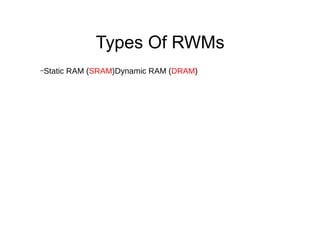Memory Unit For engineering
- 1. MEMORY UNIT
- 2. Memory Unit A memory unit is a device to which binary information is transferred for storage and from which information is retrieved when needed for processing.A memory unit stores binary information in groups of bits called words.The internal structure of memory unit is specified by the number of words it contains and the number of bits in each word.The memory unit is an essential component in any digital computer since it is needed for storing programs and data. Not all accumulated information is needed by the CPU at the same time.Therefore, it is more economical to use low-cost storage devices to serve as a backup for storing the information that is not currently used by CPU
- 3. Classification In general the memory is classified in two types based on their mode of access of a memory system. 1. Random Access Memory: The world of data reading or writing from or to the memory requires same time. We can access the data randomly. Example: hard disk. 2.Sequential Access Memory: The information stored in some medium is not immediately accessible but is available as certain intervals of time. The access time is variable. Example: magnetic tape.
- 4. Random Access Memory RAM can perform both Write and Read operations.The architecture of memory is such that information can be selectively retrieved from any of its internal locations. The time it takes to transfer information to or from any desired random location is always the same – hence the name random access memory.Integrated circuit RAM units are available in two operating modes: static and dynamic.RAMs are categorized into ROMs,Read Write Memories(RWMs) and Read Mostly Memories(RMMs).
- 5. RAM The write input causes binary data to be transferred into the memory, and the read input causes binary data to be transferred out of memory.
- 6. ROM ROM stands for Read Only MemoryRead means output data-bits corresponding to the address bits set at the input. The bits are used by some processor or device or circuit for further operations.Data bits of different addresses store at ROM and all bits remain stored in the memory even after a power interruption or power switch OFFROM is randomly accessed. An equal time interval is taken for a read of data-bits from each address. Address bits can be set randomly by an external circuit.ROM has an address decoder (n to 2n) decoder within it.
- 7. ROM ROM is used for storing programs that are PERMENTLY resident in the computer and for tables of constants that do not change in value once the production of the computer is completed.
- 8. Types Of ROM 1.Masked Programmed ROMs :- These chips are integrated circuits that physically encode the data to be stored, and thus it is impossible to change their contents after fabrication.The main advantage of mask ROM is its cost. Per bit, mask ROM is more compact than any other kind of semiconductor memory. Since the cost of an integrated circuit strongly depends on its size, mask ROM is significantly cheaper than any other kind of semiconductor memory. However, the one-time masking cost is
- 9. 2.User Programmed PROMs Programmable Read-Only Memory (PROM) is read-only memory (ROM) that can be modified once by a user. A typical PROM comes with all bits reading as "1". Burning a fuse bit during programming causes the bit to read as "0"The difference between a PROM and a ROM (readonly memory) is that a PROM is manufactured as blank memory, whereas a ROM is programmed during the manufacturing process. To write data onto a PROM chip, you need a special device called a PROM programmer or PROM burner. The process of programming a
- 10. Types Of RWMs –Static RAM (SRAM)Dynamic RAM (DRAM)
- 11. Types Of RMMs EPROM (Erasable Programmable Read-Only Memory) is programmable read-only memory (programmable ROM) that can be erased and reused.Once programmed, an EPROM can be erased by exposing it to strong ultraviolet light source.An EPROM differs from a PROM in that a PROM can be written to only once and cannot be erased.EPROMs are used widely in personal computers because they enable the manufacturer to change the contents of the PROM.
- 12. 2.EEPROM EEPROM stands for Electrically Erasable and Programmable Read Only Memory.EEPROM is a type of non-volatile memory used in computers and other electronic devices to store small amounts of data that must be saved when power is removed, e.g., calibration tables or device configuration. Unlike EPROM chips, EEPROMs do not need to be removed from the computer to be modified.It also has a limited life i.e. the number of times it can be reprogrammed is limited to tens or hundreds of thousands of times.Applicationsstoring current date and time,storing port statusses.
- 14. Flash Memory Flash Memory is a special form of EEPROM, which uses normal PC voltages for erasure and reprogramming.Flash memory is often used to hold control code such as the basic input/output system (BIOS) in a personal computer.When BIOS needs to be changed (rewritten), the flash memory can be written to in block (rather than byte) sizes, making it easy to update.Examples of flash memory device applications are storing messages in a mobile phone, storing photographs in a digital camera.














